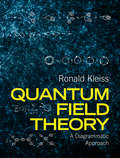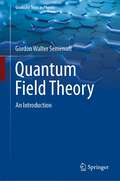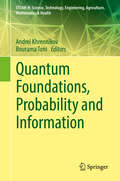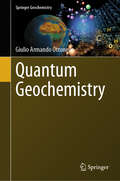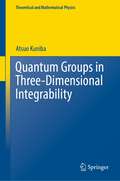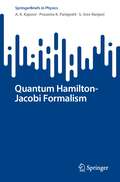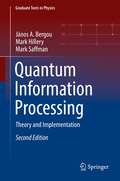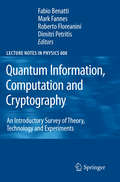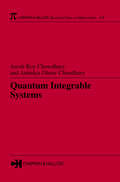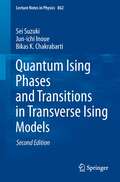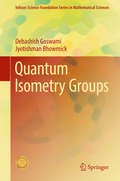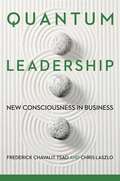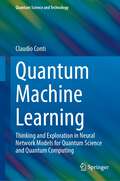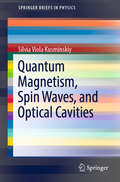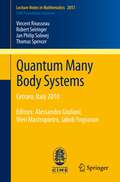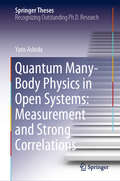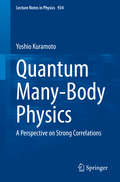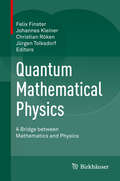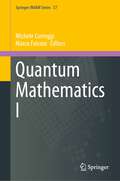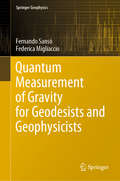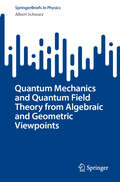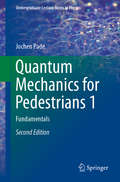- Table View
- List View
Quantum Field Theory: A Diagrammatic Approach
by Ronald KleissQuantum field theory (QFT), the language of particle physics, is crucial to a physicist's graduate education. Based on lecture notes for courses taught for many years at Radboud University in the Netherlands, this book presents an alternative approach to teaching QFT using Feynman diagrams. A diagrammatic approach to understanding QFT exposes young physicists to an orthogonal introduction to the theory, bringing new ways to understand challenges in the field. Diagrammatic techniques using Feynman diagrams are used didactically, starting from simple discussions in lower dimensions to more complex topics in the Standard Model. Worked-out examples and exercises help the reader develop a deep understanding and intuition that enhances their problem-solving skills and understanding of QFT. Classroom-tested, this accessible textbook is valuable for physics graduates and for researchers.
Quantum Field Theory: An Introduction (Graduate Texts in Physics)
by Gordon Walter SemenoffThis textbook is intended to be used in an introductory course in quantum field theory. It assumes the standard undergraduate education of a physics major and it is designed to appeal to a wide array of physics graduate students, from those studying theoretical and experimental high energy physics to those interested in condensed matter, optical, atomic, nuclear and astrophysicists. It includes a thorough development of the field theoretic approach to nonrelativistic many-body physics as a step in developing a broad-based working knowledge of some of the basic aspects of quantum field theory. It presents a logical, step by step systematic development of relativistic field theory and of functional techniques and their applications to perturbation theory with Feynman diagrams, renormalization, and basic computations in quantum electrodynamics.
Quantum Field Theory: From Basics to Modern Topics
by François GelisThis modern text combines fundamental principles with advanced topics and recent techniques in a rigorous and self-contained treatment of quantum field theory.Beginning with a review of basic principles, starting with quantum mechanics and special relativity, students can refresh their knowledge of elementary aspects of quantum field theory and perturbative calculations in the Standard Model. Results and tools relevant to many applications are covered, including canonical quantization, path integrals, non-Abelian gauge theories, and the renormalization group. Advanced topics are explored, with detail given on effective field theories, quantum anomalies, stable extended field configurations, lattice field theory, and field theory at a finite temperature or in the strong field regime. Two chapters are dedicated to new methods for calculating scattering amplitudes (spinor-helicity, on-shell recursion, and generalized unitarity), equipping students with practical skills for research. Accessibly written, with numerous worked examples and end-of-chapter problems, this is an essential text for graduate students. The breadth of coverage makes it an equally excellent reference for researchers.
Quantum Foundations, Probability and Information (STEAM-H: Science, Technology, Engineering, Agriculture, Mathematics & Health)
by Bourama Toni Andrei KhrennikovComposed of contributions from leading experts in quantum foundations, this volume presents viewpoints on a number of complex problems through informational, probabilistic, and mathematical perspectives and features novel mathematical models of quantum and subquantum phenomena. Rich with multi-disciplinary mathematical content, this book includes applications of partial differential equations in quantum field theory, differential geometry, oscillatory processes and vibrations, and Feynman integrals for quickly growing potential functions. Due to rapid growth in the field in recent years, this volume aims to promote interdisciplinary collaboration in the areas of quantum probability, information, communication and foundation, and mathematical physics. Many papers discuss complex yet novel problems that depart from the mainstream of quantum physical studies. Others devote explanation to fundamental problems of the conventional quantum theory, including its mathematical formalism. Overall, authors cover a diverse set of topics, including quantum and classical field theory and oscillatory processing, quantum mechanics from a Darwinian evolutionary perspective, and biological applications of quantum theory.Together in one volume, these essays will be useful to experts in the corresponding areas of quantum theory. Theoreticians, experimenters, mathematicians, and even philosophers in quantum physics and quantum probability and information theory can consider this book a valuable resource.
Quantum Geochemistry (Springer Geochemistry)
by Giulio Armando OttonelloThis book summarizes recent impressive improvements in the application of Quantum Mechanics, coupled with the significant increase in both speed and storage capabilities of modern computers, that allow to depict the energy and reactive properties of chemically complex materials through first principles and destroy the dogmatic assumption that the natural complexity cannot be modeled. It presents methods of Quantum Chemistry applied to various fields of geoscience. The book aims to convey to the audience, methods and procedures apt to obtain sound thermodynamic and thermo-physical data for earth’s materials under various aggregation states. The attention of this book focusses on the applicative aspects of the various procedures, with reference to the underlying theory.
Quantum Gravity and the Functional Renormalization Group: The Road towards Asymptotic Safety (Cambridge Monographs on Mathematical Physics)
by Martin Reuter Frank SaueressigDuring the past two decades the gravitational asymptotic safety scenario has undergone a major transition from an exotic possibility to a serious contender for a realistic theory of quantum gravity. It aims at a mathematically consistent quantum description of the gravitational interaction and the geometry of spacetime within the realm of quantum field theory, which keeps its predictive power at the highest energies. This volume provides a self-contained pedagogical introduction to asymptotic safety, and introduces the functional renormalization group techniques used in its investigation, along with the requisite computational techniques. The foundational chapters are followed by an accessible summary of the results obtained so far. It is the first detailed exposition of asymptotic safety, providing a unique introduction to quantum gravity and it assumes no previous familiarity with the renormalization group. It serves as an important resource for both practising researchers and graduate students entering this maturing field.
Quantum Groups in Three-Dimensional Integrability (Theoretical and Mathematical Physics)
by Atsuo KunibaQuantum groups have been studied intensively in mathematics and have found many valuable applications in theoretical and mathematical physics since their discovery in the mid-1980s. Roughly speaking, there are two prototype examples of quantum groups, denoted by Uq and Aq. The former is a deformation of the universal enveloping algebra of a Kac–Moody Lie algebra, whereas the latter is a deformation of the coordinate ring of a Lie group. Although they are dual to each other in principle, most of the applications so far are based on Uq, and the main targets are solvable lattice models in 2-dimensions or quantum field theories in 1+1 dimensions. This book aims to present a unique approach to 3-dimensional integrability based on Aq. It starts from the tetrahedron equation, a 3-dimensional analogue of the Yang–Baxter equation, and its solution due to work by Kapranov–Voevodsky (1994). Then, it guides readers to its variety of generalizations, relations to quantum groups, and applications. They include a connection to the Poincaré–Birkhoff–Witt basis of a unipotent part of Uq, reductions to the solutions of the Yang–Baxter equation, reflection equation, G2 reflection equation, matrix product constructions of quantum R matrices and reflection K matrices, stationary measures of multi-species simple-exclusion processes, etc. These contents of the book are quite distinct from conventional approaches and will stimulate and enrich the theories of quantum groups and integrable systems.
Quantum Hamilton-Jacobi Formalism (SpringerBriefs in Physics)
by A. K. Kapoor Prasanta K. Panigrahi S. Sree RanjaniThis book describes the Hamilton-Jacobi formalism of quantum mechanics, which allowscomputation of eigenvalues of quantum mechanical potential problems without solving for thewave function. The examples presented include exotic potentials such as quasi-exactly solvablemodels and Lame an dassociated Lame potentials. A careful application of boundary conditionsoffers an insight into the nature of solutions of several potential models. Advancedundergraduates having knowledge of complex variables and quantum mechanics will find thisas an interesting method to obtain the eigenvalues and eigen-functions. The discussion oncomplex zeros of the wave function gives intriguing new results which are relevant foradvanced students and young researchers. Moreover, a few open problems in research arediscussed as well, which pose a challenge to the mathematically oriented readers.
Quantum Information Processing: Theory and Implementation (Graduate Texts in Physics)
by Mark Hillery János A. Bergou Mark SaffmanThis new edition of a well-received textbook provides a concise introduction to both the theoretical and experimental aspects of quantum information at the graduate level. While the previous edition focused on theory, the book now incorporates discussions of experimental platforms. Several chapters on experimental implementations of quantum information protocols have been added: implementations using neutral atoms, trapped ions, optics, and solidstate systems are each presented in its own chapter. Previous chapters on entanglement, quantum measurements, quantum dynamics, quantum cryptography, and quantum algorithms have been thoroughly updated, and new additions include chapters on the stabilizer formalism and the Gottesman-Knill theorem as well as aspects of classical and quantum information theory. To facilitate learning, each chapter starts with a clear motivation to the topic and closes with exercises and a recommended reading list. Quantum Information Processing: Theory and Implementation will be essential to graduate students studying quantum information as well as and researchers in other areas of physics who wish to gain knowledge in the field.
Quantum Information, Computation and Cryptography
by Fabio Benatti Dimitri Petritis Mark Fannes Roberto FloreaniniThis multi-authored textbook addresses graduate students with a background in physics, mathematics or computer science. No research experience is necessary. Consequently, rather than comprehensively reviewing the vast body of knowledge and literature gathered in the past twenty years, this book concentrates on a number of carefully selected aspects of quantum information theory and technology. Given the highly interdisciplinary nature of the subject, the multi-authored approach brings together different points of view from various renowned experts, providing a coherent picture of the subject matter. The book consists of ten chapters and includes examples, problems, and exercises. The first five present the mathematical tools required for a full comprehension of various aspects of quantum mechanics, classical information, and coding theory. Chapter 6 deals with the manipulation and transmission of information in the quantum realm. Chapters 7 and 8 discuss experimental implementations of quantum information ideas using photons and atoms. Finally, chapters 9 and 10 address ground-breaking applications in cryptography and computation.
Quantum Integrable Systems (Chapman And Hall/crc Research Notes In Mathematics Ser. #Vol. 435)
by Asesh Roy Chowdhury Aninlya Ghose ChoudhuryThe study of integrable systems has opened new horizons in classical physics over the past few decades, particularly in the subatomic world. Yet despite the field now having reached a level of maturity, very few books provide an introduction to the field accessible to specialists and nonspecialists alike, and none offer a systematic survey of the m
Quantum Ising Phases and Transitions in Transverse Ising Models
by Bikas K. Chakrabarti Jun-Ichi Inoue Sei SuzukiQuantum phase transitions, driven by quantum fluctuations, exhibit intriguing features offering the possibility of potentially new applications, e.g. in quantum information sciences. Major advances have been made in both theoretical and experimental investigations of the nature and behavior of quantum phases and transitions in cooperatively interacting many-body quantum systems. For modeling purposes, most of the current innovative and successful research in this field has been obtained by either directly or indirectly using the insights provided by quantum (or transverse field) Ising models because of the separability of the cooperative interaction from the tunable transverse field or tunneling term in the relevant Hamiltonian. Also, a number of condensed matter systems can be modeled accurately in this approach, hence granting the possibility to compare advanced models with actual experimental results. This work introduces these quantum Ising models and analyses them both theoretically and numerically in great detail. With its tutorial approach the book addresses above all young researchers who wish to enter the field and are in search of a suitable and self-contained text, yet it will also serve as a valuable reference work for all active researchers in this area.
Quantum Isometry Groups
by Debashish Goswami Jyotishman BhowmickThis book offers an up-to-date overview of the recently proposed theory of quantum isometry groups. Written by the founders, it is the first book to present the research on the "quantum isometry group", highlighting the interaction of noncommutative geometry and quantum groups, which is a noncommutative generalization of the notion of group of isometry of a classical Riemannian manifold. The motivation for this generalization is the importance of isometry groups in both mathematics and physics. The framework consists of Alain Connes' "noncommutative geometry" and the operator-algebraic theory of "quantum groups". The authors prove the existence of quantum isometry group for noncommutative manifolds given by spectral triples under mild conditions and discuss a number of methods for computing them. One of the most striking and profound findings is the non-existence of non-classical quantum isometry groups for arbitrary classical connected compact manifolds and, by using this, the authors explicitly describe quantum isometry groups of most of the noncommutative manifolds studied in the literature. Some physical motivations and possible applications are also discussed.
Quantum Leadership: New Consciousness in Business
by Chris Laszlo Frederick Chavalit TsaoIn this new book, Frederick Chavalit Tsao and Chris Laszlo argue that current approaches to leadership fail to produce positive outcomes for either businesses or the communities they serve. Employee disengagement and customer fickleness remain high, resulting in a lack of creativity and collaboration at all levels of entrepreneurial activity. Investor demand for Environmental, Social, and Governance (ESG) continues to be poorly integrated into profit strategies. Drawing on extensive research, this book shows how changing a person's consciousness is the most powerful lever for unlocking his or her leadership potential to create wealth and serve humankind. A wide range of practices of connectedness provide the keys. The journey to higher consciousness changes people at a deep intuitive level, combining embodied experience with analytic-cognitive skill development. Tsao and Laszlo show how leaders who pursue this journey are more likely to flourish with significant benefits to both business and society. These include greater creativity and collaboration along with an increased capability to inspire people and produce lasting change. Readers will come away with a deep understanding of quantum leadership and the day-to-day practices that can help them achieve greater effectiveness and wellbeing at work.
Quantum Machine Learning: Thinking and Exploration in Neural Network Models for Quantum Science and Quantum Computing (Quantum Science and Technology)
by Claudio ContiThis book presents a new way of thinking about quantum mechanics and machine learning by merging the two. Quantum mechanics and machine learning may seem theoretically disparate, but their link becomes clear through the density matrix operator which can be readily approximated by neural network models, permitting a formulation of quantum physics in which physical observables can be computed via neural networks. As well as demonstrating the natural affinity of quantum physics and machine learning, this viewpoint opens rich possibilities in terms of computation, efficient hardware, and scalability. One can also obtain trainable models to optimize applications and fine-tune theories, such as approximation of the ground state in many body systems, and boosting quantum circuits’ performance. The book begins with the introduction of programming tools and basic concepts of machine learning, with necessary background material from quantum mechanics and quantum information also provided. This enables the basic building blocks, neural network models for vacuum states, to be introduced. The highlights that follow include: non-classical state representations, with squeezers and beam splitters used to implement the primary layers for quantum computing; boson sampling with neural network models; an overview of available quantum computing platforms, their models, and their programming; and neural network models as a variational ansatz for many-body Hamiltonian ground states with applications to Ising machines and solitons. The book emphasizes coding, with many open source examples in Python and TensorFlow, while MATLAB and Mathematica routines clarify and validate proofs. This book is essential reading for graduate students and researchers who want to develop both the requisite physics and coding knowledge to understand the rich interplay of quantum mechanics and machine learning.
Quantum Magnetism, Spin Waves, and Optical Cavities (SpringerBriefs in Physics)
by Silvia Viola KusminskiyThis primer thoroughly covers the fundamentals needed to understand the interaction of light with magnetically ordered matter and it focuses on "cavity optomagnonics" which is a topic undergoing intense study in current research.The book is unique in combining elements of electromagnetism, quantum magnetism, and quantum optics and it is intended for advanced undergraduate or graduate students.
Quantum Many Body Systems
by Vieri Mastropietro Jakob Yngvason Vincent Rivasseau Jan Philip Solovej Thomas Spencer Alessandro Giuliani Robert SeiringerThe book is based on the lectures given at the CIME school "Quantum many body systems" held in the summer of 2010. It provides a tutorial introduction to recent advances in the mathematics of interacting systems, written by four leading experts in the field: V. Rivasseau illustrates the applications of constructive Quantum Field Theory to 2D interacting electrons and their relation to quantum gravity; R. Seiringer describes a proof of Bose-Einstein condensation in the Gross-Pitaevski limit and explains the effects of rotating traps and the emergence of lattices of quantized vortices; J.-P. Solovej gives an introduction to the theory of quantum Coulomb systems and to the functional analytic methods used to prove their thermodynamic stability; finally, T. Spencer explains the supersymmetric approach to Anderson localization and its relation to the theory of random matrices. All the lectures are characterized by their mathematical rigor combined with physical insights.
Quantum Many-Body Physics in Open Systems: Measurement and Strong Correlations (Springer Theses)
by Yuto AshidaThis book studies the fundamental aspects of many-body physics in quantum systems open to an external world. Recent remarkable developments in the observation and manipulation of quantum matter at the single-quantum level point to a new research area of open many-body systems, where interactions with an external observer and the environment play a major role. The first part of the book elucidates the influence of measurement backaction from an external observer, revealing new types of quantum critical phenomena and out-of-equilibrium dynamics beyond the conventional paradigm of closed systems. In turn, the second part develops a powerful theoretical approach to study the in- and out-of-equilibrium physics of an open quantum system strongly correlated with an external environment, where the entanglement between the system and the environment plays an essential role. The results obtained here offer essential theoretical results for understanding the many-body physics of quantum systems open to an external world, and can be applied to experimental systems in atomic, molecular and optical physics, quantum information science and condensed matter physics.
Quantum Many-Body Physics: A Perspective on Strong Correlations (Lecture Notes in Physics #934)
by Yoshio KuramotoThis book offers a compact tutorial on basic concepts and tools in quantum many-body physics, and focuses on the correlation effects produced by mutual interactions.The content is divided into three parts, the first of which introduces readers to perturbation theory. It begins with the simplest examples—hydrogen and oxygen molecules—based on their effective Hamiltonians, and looks into basic properties of electrons in solids from the perspective of localized and itinerant limits. Readers will also learn about basic theoretical methods such as the linear response theory and Green functions. The second part focuses on mean-field theory for itinerant electrons, e.g. the Fermi liquid theory and superconductivity. Coulomb repulsion among electrons is addressed in the context of high-Tc superconductivity in cuprates and iron pnictides. A recent discovery concerning hydride superconductors is also briefly reviewed. In turn, the third part highlights quantum fluctuation effects beyond the mean-field picture. Discussing the dramatic renormalization effect in the Kondo physics, it provides a clear understanding of nonperturbative interaction effects. Further it introduces readers to fractionally charged quasi-particles in one and two dimensions. The last chapter addresses the dynamical mean field theory (DMFT).The book is based on the author’s long years of experience as a lecturer and researcher. It also includes reviews of recent focus topics in condensed matter physics, enabling readers to not only grasp conventional condensed matter theories but also to catch up on the latest developments in the field.
Quantum Mathematical Physics
by Felix Finster Johannes Kleiner Christian Röken Jürgen TolksdorfQuantum physics has been highly successful for more than 90 years. Nevertheless, a rigorous construction of interacting quantum field theory is still missing. Moreover, it is still unclear how to combine quantum physics and general relativity in a unified physical theory. Attacking these challenging problems of contemporary physics requires highly advanced mathematical methods as well as radically new physical concepts. This book presents different physical ideas and mathematical approaches in this direction. It contains a carefully selected cross-section of lectures which took place in autumn 2014 at the sixth conference ``Quantum Mathematical Physics - A Bridge between Mathematics and Physics'' in Regensburg, Germany. In the tradition of the other proceedings covering this series of conferences, a special feature of this book is the exposition of a wide variety of approaches, with the intention to facilitate a comparison. The book is mainly addressed to mathematicians and physicists who are interested in fundamental questions of mathematical physics. It allows the reader to obtain a broad and up-to-date overview of a fascinating active research area.
Quantum Mathematics I (Springer INdAM Series #57)
by Michele Correggi Marco FalconiThis book is the first volume that provides an unique overview of the most recent and relevant contributions in the field of mathematical physics with a focus on the mathematical features of quantum mechanics. It is a collection of review papers together with brand new works related to the activities of the INdAM Intensive Period "INdAM Quantum Meetings (IQM22)", which took place at the Politecnico di Milano in Spring 2022 at Politecnico di Milano. The range of topics covered by the book is wide, going ranging from many-body quantum mechanics to semiclassical analysis, quantum field theory, Schrödinger and Dirac operators and open quantum systems
Quantum Mathematics II (Springer INdAM Series #58)
by Michele Correggi Marco FalconiThis book is the second volume that provides an unique overview of the most recent and relevant contributions in the field of mathematical physics with a focus on the mathematical features of quantum mechanics. It is a collection of review papers together with brand new works related to the activities of the INdAM Intensive Period "INdAM Quantum Meetings (IQM22)", which took place at the Politecnico di Milano in Spring 2022 at Politecnico di Milano. The range of topics covered by the book is wide, going ranging from many-body quantum mechanics to quantum field theory and open quantum systems.
Quantum Measurement of Gravity for Geodesists and Geophysicists (Springer Geophysics)
by Fernando Sansò Federica MigliaccioDuring the last thirty years a great advancement in low energy physics, particularly interactions of atoms with the electromagnetic field, has been achieved and the development of electronics and laser techniques has allowed to implement a fine manipulation of atoms with photons. A wealth of important applications has sprung out from the ability of manipulating large samples of cold atoms. Among them, the improvement of atomic clocks and the creation of atomic gyroscopes and of atomic gravity meters, which is obviously of great interest for geodesists and geophysicists, particularly for potential applications in satellite geodesy.This book explains the fundamental concepts necessary to understand atom manipulation by photons, including the principles of quantum mechanics. It is conceived as a road that leads the reader from classical physics (mechanics and electromagnetism, considered as a common scientific background of geodesists and geophysicists), to the basics of quantum mechanics in order to understand the dynamics of atoms falling in the gravity field, while interacting with suitably resonant laser beams. There are different types of measurements of gravity based on the manipulation of ultra-cold atoms; the book presents the principles of the instruments based on stimulated Raman transition, which can be easily worked out analytically. However, the concepts explained in the text can provide a good starting point to understand also the applications based on the so-called Block oscillations or on the Bose–Einstein condensation.
Quantum Mechanics and Quantum Field Theory from Algebraic and Geometric Viewpoints (SpringerBriefs in Physics)
by Albert SchwarzThis book offers a non-standard introduction to quantum mechanics and quantum field theory, approaching these topics from algebraic and geometric perspectives. Beginning with fundamental notions of quantum theory and the derivation of quantum probabilities from decoherence, it proceeds to prove the expression for the scattering matrix in terms of Green functions (LSZ formula), along with a similar expression for the inclusive scattering matrix. The exposition relies on recent findings by the author that provide a deeper understanding of the structure of quantum theory and extend beyond its traditional boundaries. The book is suitable for graduate students and young researchers in mathematics and theoretical physics seeking to delve into innovative concepts within quantum theory. The book contains many recent results therefore it should be interesting also to accomplished physicists and mathematicians.
Quantum Mechanics for Pedestrians 1: Fundamentals (Undergraduate Lecture Notes in Physics)
by Jochen PadeThis book, the first in a two-volume set, provides an introduction to the fundamentals of (mainly) non-relativistic quantum mechanics. This first volume chiefly focuses on the essential principles, while applications and extensions of the formalism can be found in volume 2. Including but also moving beyond material that is covered in traditional textbooks on quantum mechanics, the book discusses in detail current issues such as interaction-free quantum measurements or neutrino oscillations, as well as fundamental problems and epistemological questions, such as the measurement problem. A chapter on the postulates of quantum mechanics rounds off this first volume. In order to quickly and clearly present the main principles of quantum mechanics and its mathematical formulation, there is a systematic transition between wave mechanics and algebraic representation in the first few chapters, in which the required mathematical tools are introduced step by step. Moreover, the appendix concisely reviews the most important mathematical tools, allowing readers to largely dispense with supplementary literature. The appendix also explores advanced topics, such as the Quantum-Zeno effect and time-delay experiments. Over 250 exercises, most of them with solutions, help to deepen the reader’s understanding of the topics discussed. This revised second edition is expanded by an introduction to some ideas and problems of relativistic quantum mechanics. In this first volume, the Klein-Gordon and the Dirac equations are treated. Fundamentals of other areas are compiled in compact form, i.e., outlines of special relativity, classical field theory and electrodynamics. The book is chiefly intended for student science teachers and all students of physics, majors and minors alike, who are looking for a reasonably easy and modern introduction to quantum mechanics.
